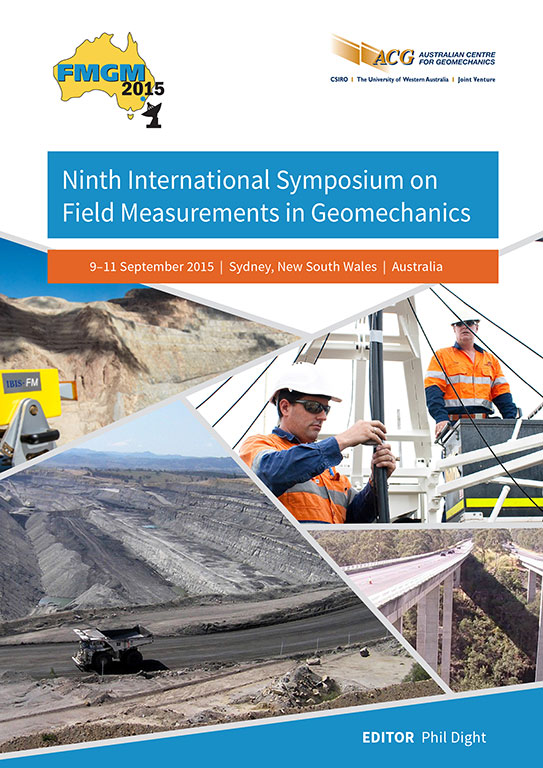Heuristic methods of back-analysis of tunnel response from field measurements using simulated annealing

|
Authors: Gutierrez, M; Vardakos, S; Caichu, X Paper is not available for download Contact Us |
DOI https://doi.org/10.36487/ACG_rep/1508_21_Gutierrez
Cite As:
Gutierrez, M, Vardakos, S & Caichu, X 2015, 'Heuristic methods of back-analysis of tunnel response from field measurements using simulated annealing', in PM Dight (ed.), FMGM 2015: Proceedings of the Ninth Symposium on Field Measurements in Geomechanics, Australian Centre for Geomechanics, Perth, pp. 339-352, https://doi.org/10.36487/ACG_rep/1508_21_Gutierrez
Abstract:
This paper deals with the use of field monitoring data to improve predictions from numerical models. Computational models are powerful tools for the performance-based engineering analysis and design of geotechnical structures. However, the main issue to their use is the paucity of information to establish input data needed to yield reliable predictions that can be used in the design of geotechnical structures. Field monitoring can offer not only the means to verify modelling results but also faster and more reliable ways to determine model parameters and for improving the reliability of model predictions. Back-analysis involves the determination of parameters required in computational models using field monitored data, and is particularly suited to underground constructions, where more information about ground conditions and response become available as the construction progresses. A crucial component of back-analysis is an algorithm to find a set of input parameters that will minimise the difference between predicted and measured performance (e.g. in terms of deformations, stresses or tunnel support loads). Methods of backanalysis can be broadly classified as direct and gradient based optimisation techniques. An alternative methodology to carry out the required nonlinear optimisation in back-analyses is the use of heuristic techniques. Heuristic methods refer to experience-based techniques for problem solving, learning, and discovery that find a solution which is not guaranteed to be optimal, but good enough for a given set of goals. This paper focuses on the use of heuristic simulated annealing (SA) in the back-analysis of tunnel responses from field monitored data. SA emulates the metallurgical processing of metals such as steel by annealing, which involves a gradual and sufficiently slow cooling of a metal from the heated phase which leads to a final material with a minimum imperfections and internal dislocations. During cooling, nature follows its own optimisation path for the given circumstances. Description of SA, its implementation in the computer code FLAC (Itasca 2008), and use in the back-analysis of the response of a twin tunnel in China are presented.
References:
Brown, E, Cundall, P, Desai, C, Hoek, E & Kaiser, P 2002, ‘The great debate in rock mechanics: data input - the Achilles heel of rock mass constitutive modeling?’, in R Hammah (ed.), Proceedings of the 5th North American Rock Mechanics Symposium and the 17th Tunnelling Association of Canada Conference, University of Toronto, Toronto.
Chern, JC, Chi, SY, Yu, CW & Jan, JC 2002, ‘Application of artificial neural network in underground construction’, Sino-Geotechnics, pp. 39-46.
Cividini, A, Jurina, G & Gioda, G 1981, ‘Some aspects of characterization problems in geomechanics’, International Journal of Rock Mechanics and Mining Sciences, vol. 18, pp. 487-503.
Cividini, A, Maier, G & Nappi, A 1983, ‘Parameter estimation of a static geotechnical model using a Bayes' rule approach’, International Journal of Rock Mechanics and Mining Sciences, vol. 20, pp. 215-226.
Dunnicliff, J 1988, Geotechnical instrumentation for monitoring field performance, Wiley-Interscience, New York.
Gioda, G & Sakurai, S 1987, ‘Back analysis procedures for the interpretation of field measurements in geomechanics’, International Journal of Numerical and Analytical Methods in Geomechanics, vol. 11, pp. 555-583.
Hashash, YMA, Marulanda, C, Ghaboussi, J & Jung, S 2003, ‘Systematic update of a deep excavation model of using field performance data’, Computers and Geotechnics, vol. 30, pp. 477-488.
Himmelblau, D 1972, Applied nonlinear programming, McGraw-Hill, New York.
Hoek, E 2003, Numerical modelling for shallow tunnels in weak rock, Rocscience, Toronto, viewed 08 June 2015, .
Itasca Consulting Group 2008, FLAC 5.0 Manual, Itasca Consulting Group, Minneapolis, MN.
Kirkpatrick, S, Gelatt, CD & Vecchi, MP 1983, ‘Optimization by simulated annealing’, Science, vol. 220, no. 4598, pp. 671-680.
Londe, P 1977, ‘Field measurements in tunnels’, in K Kovari (ed.), Proceedings of the International Symposium on Field Measurements in Geomechanics, Balkema, Rotterdam, pp. 619-638.
Metropolis, N, Rosenbluth, A, Rosenbluth, M, Telle, A & Teller, E 1953, ‘Equations of state calculations by fast computing machines’, Chemical Physics, vol. 21, pp. 1087-1092.
Panet, M 1993, ‘Understanding deformations in tunnels’, in JA Hudson, T Brown, C Fairhurst & E Hoek (eds), Comprehensive Rock Engineering, Pergamon Press, New York.
Panet, M 1995, Le calcul des tunnels par la méthode convergence-confinement, Presses de l'ENPC, Paris.
Press, W, Teukolsky, S, Vetterling, W, Flannery, B 1988, Numerical recipes in C: the art of scientific computing, Cambridge University Press, Cambridge.
Sakurai, S 1998, ‘Lessons learned from field measurements in tunnelling’, Tunnelling and Underground Space Technology, vol. 12, no. 4, pp. 453-460.
Sakurai, S, Akutagawa, S, Takeuchi, K, Shinji, M & Shimizu, N 2003, ‘Back analysis for tunnel engineering as a modern observational method.’ Tunnelling and Underground Space Technology, vol. 18, pp. 185-196.
Xiang, Z, Swoboda, G & Cen, Z 2003, ‘Optimal layout of displacement measurements for parameter identification process in geomechanics’, International Journal of Geomechanics, vol. 3, no. 2, pp. 205-216.
© Copyright 2025, Australian Centre for Geomechanics (ACG), The University of Western Australia. All rights reserved.
View copyright/legal information
Please direct any queries or error reports to repository-acg@uwa.edu.au
View copyright/legal information
Please direct any queries or error reports to repository-acg@uwa.edu.au